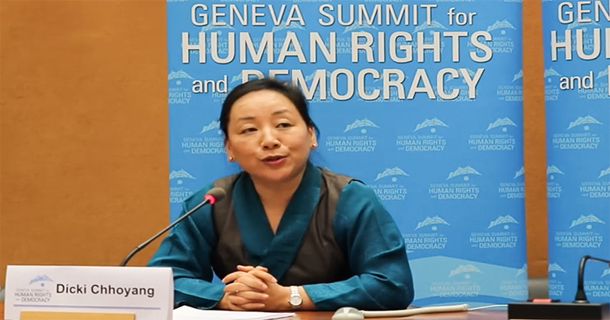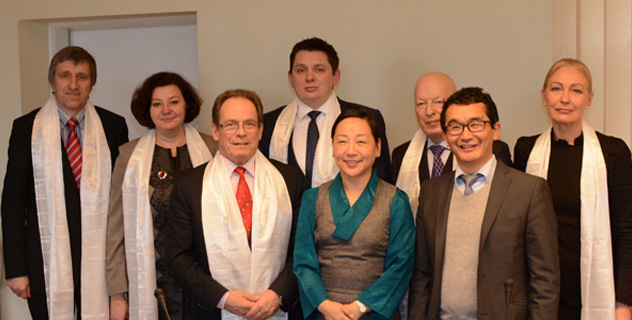The issue of the Tibetan freedom struggle and humans right violations was raised at the United Nations Summit for Human Rights and Democracy in Geneva, Switzerland, held from February 21 – 24. Among the 40 activists, human rights heroes, former political prisoners, journalists and student leaders were two Tibetans – Kalon Dicki Chhoyang of the Department of Information and International Relations, Central Tibetan Administration (CTA) based in Dharamsala, India and Tenzin Dhardon Sharling, member of the exile Tibetan parliament at Dharamshala.
At the opening session, Kalon addressed the gathering on various issues related to Tibet, speaking specifically on the critical human rights situation prevailing inside Tibet, the forced disappearance of the 11th Panchen Lama, the wave of self-immolation protests inside Tibet and the Middle-Way Approach of the Central Tibetan Administration to resolve these issues.
“There has been 135 Tibetans who self-immolated inside Tibet to protest against the People’s Republic of China’s policies in Tibet,” she said, adding that those who self-immolated include people from all regions of Tibet ranging between the ages of their late teens to their 60s, and nomads, farmers, monks, nuns, students, intellectuals, men and women. She also pointed out that despite Chinese occupation for over a half-century, Tibet continues to be a symbol of a people’s non-violent struggle for freedom, justice and dignity.
She highlighted the case of the Gedun Choekyi Nyima, the 11th Panchen Lama and one of the world’s youngest political prisoners. “It’s the tale of a little six-year-old boy who disappeared a few days after His Holiness the Dalai Lama recognised him as the 11th Panchen Lama, one of the highest-ranking lamas for Tibetan Buddhists. This year marks the twentieth anniversary of him going missing. His unknown whereabouts combined with the uninterrupted reports of other extrajudicial arrests and tortures serve as a constant reminder of the Chinese government’s disregard for human rights in Tibet,” said Kalon.
Speaking as a representative of the CTA and the voice of the Tibetan people in the free world, she travels the world to raise awareness about the human rights situation in Tibet and to seek support for what China wants to keep a secret – the Tibetan proposal to resolve the current situation inside Tibet or the Middle Way Approach. “The Middle Way Approach is based on principles that His Holiness the Dalai Lama suggested as mutually beneficial and in the spirit of dialogue and reconciliation,” she elaborated.
Kalon added that the Tibetan issue is a fight between truth and brutal force, saying that Tibet is “dealing with a ruthless regime, which has a formidable propaganda machine. And its way of handling Tibet is silence, with no information going inside Tibet and no information coming out of Tibet.
During her Europe tour, Kalon also visited Riga, the capital of Latvia, and met members of the Tibet Support Group of the Latvian Parliament. In her address, she spoke about the current state of political repression, cultural assimilation, economic marginalisation, environmental destruction and the lack of religious freedom inside Tibet. She also explained the CTA’s Middle-Way Approach proposal for resolving the Tibet issue.
Her visit also included media interviews and a talk to Latvian students, “Tibet: A Middle Way Approach towards Peace”, where she spoke on the history of Tibet, the CTA’s role, the current political situation and the proposed Middle-Way Approach for a better tomorrow. This was followed by a screening of the “Umaylam – Middle-Way Approach” video and a Q&A session.






 Print
Print Email
Email